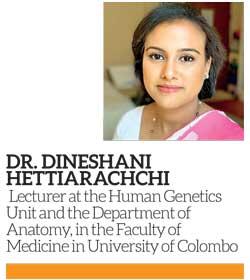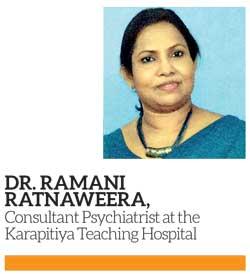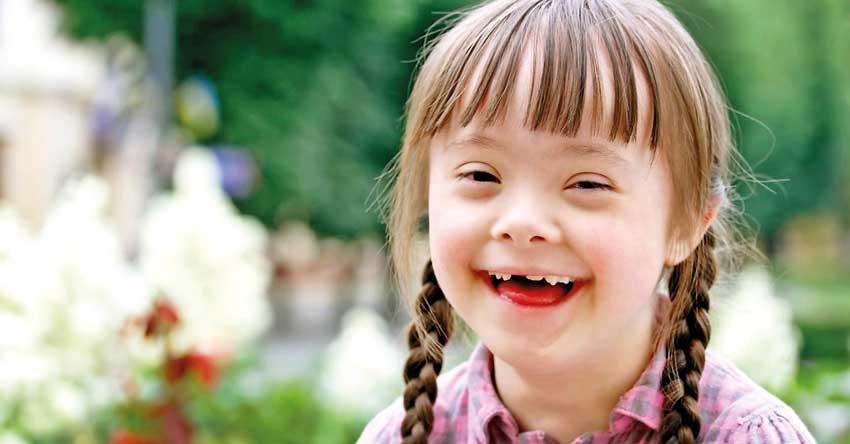
In that moment when your baby is diagnosed with Down’s syndrome, it feels as if your whole world falls apart. It’s not easy for you, as a parent to realise that your dreams of a perfect child may not be realised. It’s heartbreaking and it seems difficult to accept and move on. However, you must realise and understand that your child is absolutely perfect and he’s just different from most children because he has Down’s syndrome.
Science behind Down’s syndrome
Dr. Dineshani Hettiarachchi, who has obtained her Masters in Regenerative Medicine and is currently working as a Lecturer at the Human Genetics Unit and the Department of Anatomy, in the Faculty of Medicine in University of Colombo, defines Down’s syndrome as a genetic condition, caused by the presence of an extra chromosome in the baby’s cells.
“Every individual has 23 pairs of autosomal chromosomes and a pair of sex chromosomes (XY in case of a male, XX in case of a female). However, people with Down’s syndrome have three copies of chromosome 21, hence the medical name ‘trisomy 21’ is used,” she said.
Accordingly, the extra copy of chromosome 21 has additional genetic material which results in the range of physical and developmental characteristics associated with Down’s syndrome.
Characteristic features of Down’s syndrome
According to the World Health Organisation (WHO), some physical characteristics of Down’s syndrome in infants are,
- Decreased muscle tone
- Flat face
- Eyes slanting up
- Low set ears- When ears are positioned lower on the head than usual
- Ability to extend joints beyond the usual
- Large space between the big toe and its neighboring toe
- Large tongue relative to the mouth
- Single transverse palmar crease
Other than these physical characteristics, according Dr. Ramani Ratnaweera, Consultant Psychiatrist at the Karapitiya Teaching Hospital said that individuals with Down’s syndrome display,
- Intellectual disabilities.
- Slow development (walking, talking, etc.)
- Mild cognitive defects
- Behavioral problems
- Difficulty in adjusting to new environments
- Slow learning capabilities
- Impulsive behavior

“The characteristics displayed by these children and their abilities and disabilities vary from person to person. It depends on the environment created by their caretakers as well,” Dr. Ratnaweera said.
Furthermore, in Dr. Ratnaweera’s opinion, typically individuals with Down’s syndrome may display characteristics associated with Attention Deficit Hyperactivity Disorder (ADHD), Autistic spectrum related characteristics, signs of Obsessive-Compulsive Disorder (OCD) and even signs of Depression and Anxiety are common amongst these individuals. Moreover, they may be prone to early Dementia and cardio-vascular diseases.
Dr. Hettiarachchi emphasised that the life expectancy of these patients varies widely. Improvements in medical interventions for people with Down’s syndrome have led to a substantial increase in their longevity. According to Dr. Ratnaweera, in general their life span is about 60 years.
Positive outlook on Down’s syndrome
According to Dr. Hettiarachchi, while many children with Down syndrome may experience difficulties in learning to walk, talk and number skills, they display wide range of strengths as well.
- Social interaction – Most children with Down’s syndrome enjoy and learn from social interaction with family and friends. As time goes by, they often have good social and emotional understanding, and most are able to develop age-appropriate behavior.
- Visual learning – Children and young people with Down’s syndrome generally learn visually. This means that they learn best from watching and copying other people, and may find it easier to take in information if it is presented with the support of pictures, gestures, objects and written words.
- Gesture and mime – Children with the syndrome are often particularly good at using their hands, faces and bodies to communicate. They often enjoy drama and movement as they get older.
- Reading ability – Reading is often a strength, possibly because it builds on visual learning skills.
“Some children with Down’s syndrome excel in their studies. They are so talented. I know a child with Down’s syndrome who grew up to become a teacher who taught differently abled children. Even with all these difficulties, they can be happy,” Dr. Ratnaweera commented.
Sexual development
Dr. Ratnaweera emphasized that children with Down’s syndrome undergo sexual development similar to most children from the age of 10 years and older but it may be delayed some patients.
Therefore with age children with Down’s syndrome will experience hormonal changes, development of secondary sexual characteristics and emotional needs to engage in intimate relationships.
“It is important that we understand that these children have all the rights we do. If they find a suitable partner, it is well within their right to have a romantic relationship, get married and have an intimate meaningful relationship,” she commented.
Individuals with Down’s syndrome may be able to have children. However, according to Dr. Ratnaweera, fertility rates of females with Down’s syndrome is about 35-50% while males with Down’s syndrome are generally infertile.
Due to their intellectual disabilities, children with Down’s syndrome are prone to sexual exploitation and abuse. They lack emotional self-control. Therefore, it is important to provide age appropriate sexual education to these children.
“We must explain their sexual development in a simple and delicate manner in a way that they understand. We must teach them the culturally accepted behavior to protect them from exploitation,”
Dr. Ratnaweera emphasised.
Detecting Down’s syndrome before birth
Down’s syndrome can be identified during pregnancy itself. This may help you to be better prepared to give the best care possible for your child. Dr. Hettiarachchi said that screening could take place between 10 and 20 weeks of pregnancy.
However, she said that most of the time, it was usually completed by 14 weeks and 2 days of pregnancy. “This is so that you can have the combined test which is the recommended screening strategy in the first trimester of pregnancy,” she said. Your obstetrician will guide you and offer these screening tests for you.
According to her, there are two basic methods of screening for Down’s syndrome - the ultrasound scan and biochemical
serum screening,
Nuchal translucency ultrasound scan (also called the NT scan): this is a special ultrasound scan that is done between 11 weeks and 2 days and 14 weeks and 1 day of pregnancy. It measures the fluid collection under the skin at the back of the baby’s neck (the nuchal translucency (NT)).
Blood tests (also called biochemical serum screening): blood tests may be done to measure levels of various hormones and proteins in your blood. These hormones and proteins are produced by the placenta or the developing baby. If the baby has Down’s syndrome, the levels of these substances can be affected.
Once these screening tests are performed your obstetrician will tell you if you’re at a higher risk for having a Down’s syndrome baby. If you’re at a higher risk of having a down syndrome baby your obstetrician will offer a confirmatory test.
Down’s syndrome babies are born in every country in the world to parents of all races, religions and socio-economic backgrounds. “Anyone can have a child with Down’s syndrome. As far as we know, nothing done before or during pregnancy causes the condition,” Dr. Hettiarachchi said.
However, in her expert opinion, the chances of having a Down’s syndrome baby increases with maternal age. “Under age 25, the odds of having a child with Down syndrome are about 1 in 1,400. At age 35, the odds are about 1 in 350. At age 40, the odds are about 1 in 100,” she said.
Genetic testing and Counselling for Down’s syndrome
Dr. Hettiarachchi explained that in majority of individuals with Down’s syndrome (about 94%), each and every cell has three copies of chromosome 21 instead of the usual two, due to random errors in cell division during the formation of the gametes in the parents known as non-disjunction.
However, some other people (about 4%) with Down’s syndrome show attachment of extra chromosome 21 material to another chromosome, known as translocation DS. This condition may arise if either the mother or father has a balanced chromosomal re-arrangement involving chromosome 21 with another chromosome which can then be transmitted to the child.
About 2% of affected individuals have extra chromosome 21 material that is present only in some of their cells while the rest of the cells contain the normal 2 copies, referred to as mosaic DS. It arises due to errors in cell division in the early embryo.
“Hence once there is a clinical suspicion about Down’s syndrome it is important to perform the genetic test (Karyotype) to confirm along with pre-test and post-test counselling. We provide these services at the Human Genetics Unit, Faculty of Medicine, University of Colombo,” she emphasized.
Advice to the Parents
First and foremost, a baby with Down’s syndrome has the same needs as all babies. They will eat, sleep and cry and will need love and cuddles like any other. The most important thing that you need to know about Down’s syndrome is that everyone with the condition is a unique individual.
Dr. Hettiarachchi emphasized that children with Down’s syndrome generally need more time to reach developmental milestones and they will need some additional support to learn new skills as well as extra help when they go to school. Therefore, their parents should be more patient and supportive
Dr. Ratnaweera believes that children with Down’s syndrome may develop faster in a stimulating home environment with positive support and health facilities.
They should be taught by a special needs teacher providing them the needed individual attention Even though this might be challenging, each family member should be supportive and provide the best care possible.

 In that moment when your baby is diagnosed with Down’s syndrome, it feels as if your whole world falls apart. It’s not easy for you, as a parent to realise that your dreams of a perfect child may not be realised. It’s heartbreaking and it seems difficult to accept and move on. However, you must realise and understand that your child is absolutely perfect and he’s just different from most children because he has Down’s syndrome.
In that moment when your baby is diagnosed with Down’s syndrome, it feels as if your whole world falls apart. It’s not easy for you, as a parent to realise that your dreams of a perfect child may not be realised. It’s heartbreaking and it seems difficult to accept and move on. However, you must realise and understand that your child is absolutely perfect and he’s just different from most children because he has Down’s syndrome.  “The characteristics displayed by these children and their abilities and disabilities vary from person to person. It depends on the environment created by their caretakers as well,” Dr. Ratnaweera said.
“The characteristics displayed by these children and their abilities and disabilities vary from person to person. It depends on the environment created by their caretakers as well,” Dr. Ratnaweera said.